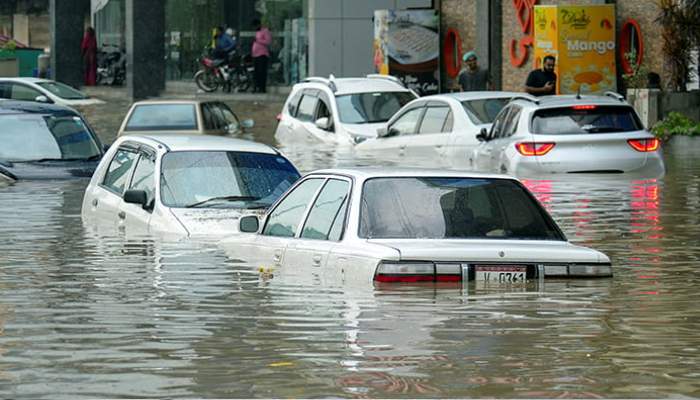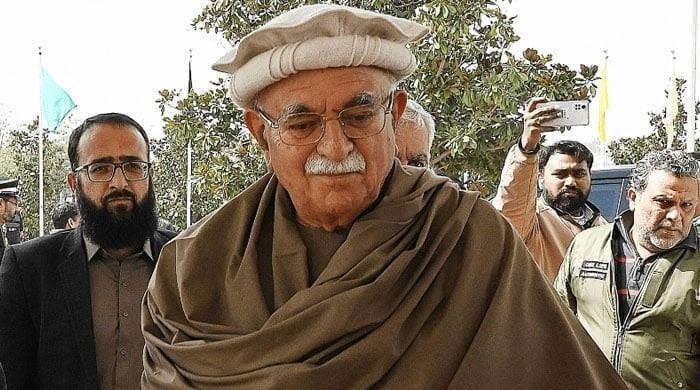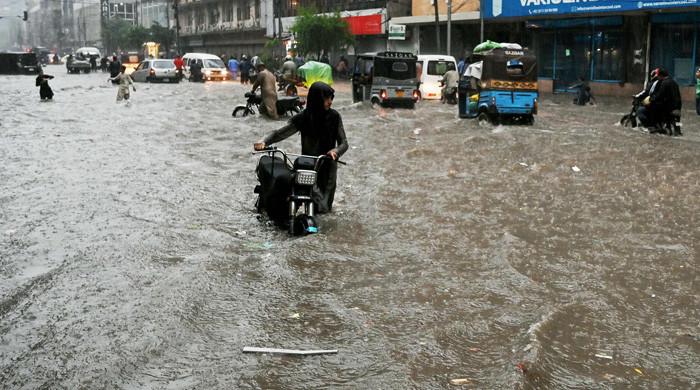Parts of Karachi suffer 48-hour blackouts as KE struggles to restore power
Sindh governor, taking note of Karachi’s electricity issues, says he will meet the power utility’s MD today
August 21, 2025

- Some neighbourhoods are without power even after two days.
- KE claims restoring power to to 94% of metropolitan city.
- Minister Malik warns next monsoon to be more destructive.
KARACHI: The country’s largest city and parts of Sindh remain affected by power outages and waterlogging on Thursday, two days after heavy monsoon rains, with officials warning that the next phase of the monsoon could cause even more damage.
With several roads still inundated in rainwater, Karachi Traffic Police has said that the Clifton Underpass was open for traffic.
Underpasses other than the Clifton one are closed for traffic, the traffic police said, adding that the Korangi River and Causeway Road were also closed for general traffic.
Sindh Governor Kamran Khan Tessori, addressing the electricity crisis, said he would meet the managing director of K-Electric, the company responsible for supplying power to the city.
Long blackouts
Citizens in several areas, including North Nazimabad, Gulistan-e-Jauhar, Defence View, Orangi Town, Lyari, Baldia Town, Liaquatabad, Surjani and Korangi Industrial Area, said they had been without electricity for more than 24 to 48 hours.
In some parts of the metropolis, outages stretched beyond 36 hours, leaving homes without water.
In Gulistan-e-Jauhar’s Block 8, residents staged a protest after 32 hours without power, while in Block 2, the supply had remained suspended since Tuesday. Parts of North Nazimabad reported 45-hour blackouts.
Similar complaints were reported from Hyderabad, where citizens said that 90% of Latifabad and Qasimabad were still in darkness, with restoration delayed for more than seven hours.
KE defends restoration efforts
K-Electric Chief Executive Officer Moonis Alvi said that more than 500 feeders tripped during the downpour, but that supply had been restored to 94% of the city by Wednesday evening.
The KE has said that electricity on only 100 feeders was cut off and power was being supplied to the city via 2,000 feeders out of the total 2,100.
Work to restore power to 100 feeders is underway, the utility provider added.
The company said that heavy waterlogging had restricted the movement of vehicles, making it difficult for field staff to reach affected sites.
Governor Tessori pledges relief
Sindh Governor Kamran Tessori, accompanied by MQM leader Dr Farooq Sattar, visited flood-hit parts of the city late Wednesday night. Later, addressing a press conference, he said that electricity shortages had become the city’s biggest challenge.
He told reporters that in Surjani, families were forced to sleep on rooftops as rainwater entered their homes. He added that food distribution had begun in the area and urged urgent drainage of low-lying zones.
Tessori said Governor House’s complaints cell had received more than 11,000 grievances in a single day, mostly about outages. Similar complaint centres would soon be opened in Hyderabad and Mirpurkhas, he added.
“This is not a time to shift all the blame to climate change," he underlined.
"Once the crisis passes, we must address the real causes of these failures,” Tessori said, announcing that K-Electric’s managing director had been summoned for a briefing today.
Two brothers electrocuted
Meanwhile, two brothers lost their lives after being electrocuted in Natha Khan Goth during Tuesday’s storm.
Police said the victims were identified as 21-year-old Murad and his 16-year-old brother, Siraj.
Their father has lodged a case at Shah Faisal Colony police station, where officers have included charges of manslaughter against K-Electric officials.
Minister warns of stronger monsoon ahead
Federal Climate Change Minister Dr Musadik Malik has warned that the current spell of rain is likely to continue until September 10, while the next monsoon system is expected to be even more intense.
Speaking on Geo News programme Capital Talk, Malik said preparations must begin immediately for the upcoming monsoon spell.
Referring to recent flooding in Khyber Pakhtunkhwa, he said that cloudbursts and flash floods can sweep away massive boulders “like straws,” causing widespread devastation.
He warned that hotels and resorts built in the paths of floods could collapse into debris, adding to the destruction.
Speaking on the same late-night talk show, Sindh Minister Nasir Hussain Shah also acknowledged the limits of Karachi’s drainage system, saying its capacity was just 40mm, making it impossible to cope with rainfall of 200mm.
Environmental expert Dr Zainab Naeem warned that unchecked stone-crushing in mountains had led to increased flood risks, with little regulation in place.











